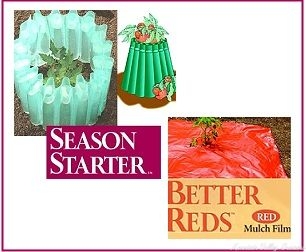Growing & using Cherry Bomb Pepper
CHERRY BOMB PEPPERS---2,500-5,000 Scoville Units
Looking like big cherry tomatoes, these chilis are full of moderately spicy flavor. About two inches around, they make nice stuffing peppers for your appetizer tray.
Hot Peppers originate in Central and South America so it is no surprise that they prefer warm weather and warm soil to grow in. Pepper transplants should go into the garden in spring as soon as the night time temperatures are around 55 and there is no more danger of frost. A cold soggy soil will slow growth and possibly kill a pepper plant.
Chili Peppers come in all sizes and shapes. They range from extremely hot to just a bit of heat. Some are so hot that they are barely edible. Indeed these peppers are often made into sauces instead of eaten fresh. The chili peppers most often used are more versatile and can be used as a main part of the meal or as seasoning.
Wearing rubber gloves when working with hot peppers keeps unintended discomfort to a minimum. Removing seeds and inner white ribs can cool a pepper down a bit. As in all cooking it is best to taste the pepper before you decide how much to use.
Chili peppers can be dried and later rehydrated. Dried chilies have a different flavor than fresh chilies. Often it takes fewer dried chilies for a recipe than fresh. Waiting until the chili has turned red or is mature is best for drying. To dry chilies it is best to either string them together and hang in a warm dry spot or lay them flat on a screen in a warm dry spot. Leaving air space between each chili on the screen will facilitate drying. Make sure they are completely dry before storing them in an airtight container.

Soil should be well drained with plenty of organic matter. In cold spring areas, mulches can help warm up the ground and give the peppers a boost. Red Mulch has been shown to be very effective in increasing the yield of peppers, not only in the north, but throughout the United States. Plastic cones filled with water Season Starters also boost the temperature and with peppers every little bit counts.
Fertilize with an all purpose fertilizer at planting and, as the plant sets more flowers, add a vegetable fertilizer. Watering should be consistent and plentiful but soil should not become so wet that roots cannot get air. Space plants about every 18 to 24 inches in full sun. If flowers form on very small plants, they should be removed so the plants can make more leaves before setting fruit. The abundance of leaves helps the plant to make food and provides shade for the fruit when the sun is scorching hot.
